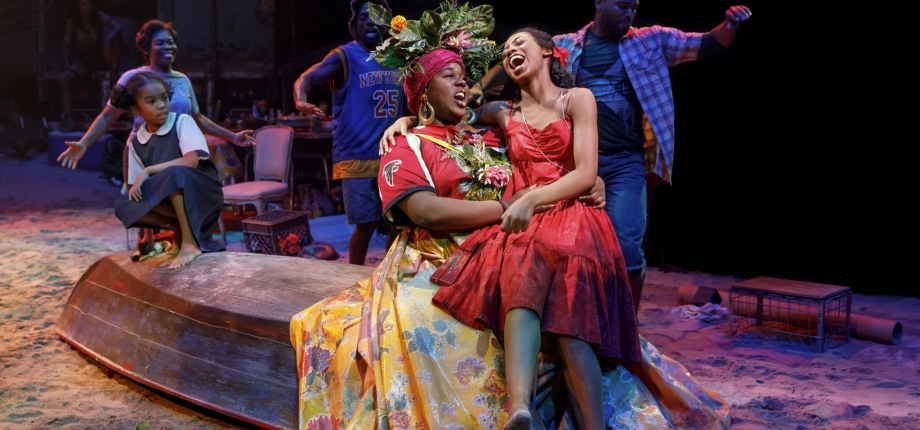Filichia Features: Once on This Island, the Second Time Around

Filichia Features: Once on This Island, the Second Time Around
You could use two keyboards, an electric bass, percussion, and a reed as the original production did.
Or you could employ a keyboard, electric bass, flute, percussion, mandolin, acoustic and electric guitars and even an electric sitar as the current revival does.
Whichever way you choose to do Once on This Island, don't miss the chance to replicate the unique sounds of the current Tony-winning revival.
For more than a quarter-century, audiences have flocked to the story of Ti Moune, the peasant lass who loved not wisely but too well (and well above her station, as the high-born Beauxhommes would insist).
No wonder that last autumn producers resuscitated the show for a Broadway revival that's still at Circle in the Square (and will soon surpass the original's 469-performance run).
Once on This Island joined only seven other musicals that were nominated for a Best Musical Tony but lost - and yet wound up winning in the revival category.
Moreover, this new production accumulated eight Tony nominations - just as many as the original had notched. That's all the more impressive when you remember that Lynn Ahrens' book and lyrics and Stephen Flaherty's music - good for three of those eight Tony nominations in 1991 - weren't eligible this time around.
One of those eight in 2018 went to Michael Starobin and AnnMarie Milazzo for Best Orchestrations. He did the original charts in 1990; she was new to the show. That might lead one to believe that Milazzo reworked Starobin's orchestrations while he simply sat home.
No.
"Both Michael and AnnMarie did a ton of new work," Ahrens says. "AnnMarie's orchestrations are vocal. She created extraordinary texture and fullness out of the actor's voices, coloring and enhancing the original vocal lines."
Says Flaherty, "The orchestrations for this production are entirely new, not just merely adapted from the previous production. Michael enhanced the score for the 'trash' and 'real' instruments with AnnMarie."
"Trash instruments," you ask? Meaning the thousands of brass, strings and woodwinds that have been discarded once the people who played them lost interest?
No again.
Says Ahrens, "Michael actually created a 'handmade' orchestral sound, working with John Bertles of 'Bash the Trash.'" (It's an arts and educational organization that creates music from recycled and reused materials).
Employing broken ceramic tiles and a tennis racket would be thought to make a racket and not music, but here they stand in for xylophones. Instead of maracas, there are cans and bottles that contain a sampling of sunflower seeds. Cardboard tubes, aquarium rocks and PVC pipes — those made from a synthetic plastic polymer — all function as rainsticks. Funnels, garden hoses and pipes substitute for a horn section. Medicine bottles become flutes and Styrofoam produces sounds not unlike a cello's.
Offers Flaherty, "The resulting sound is much more acoustic than what we originally had on Broadway, swapping many of the electronic keyboard textures for 'vocal pads' created by the actors. The idea was to give this production a much more 'human' sound, less processed, less electronic. We wanted our audiences to believe that the show could be created sonically with whatever happened to be at hand."
And those are the key words: whatever happened to be at hand. As Ahrens describes it, "The concept is that even after the devastation of a storm, people make music and art any way they can, out of whatever comes to hand."
You'll recall that the reason why the residents of this French Antilles island tell the story is to assuage a young girl's fears after that horrific monsoon. Art, as we all know, has the power to do some healing.
Adds Ahrens, "I couldn't be more thrilled with the sound Michael and AnnMarie created, which is not only alive and human, but also on a scale and quality that works perfectly with director Michael Arden's concept."
"To execute these new vocal orchestrations — much more elaborate than the originals — we've had to expand the cast," continues Flaherty, noting there were 11 on Broadway and now there are 17." The expanded cast is seldom a problem for community theaters and even more rarely for high school programs. So even if you've done Once on This Island once, maybe the time has come for a second production using those so-called "trashstruments."
"These new orchestrations give this production an exciting, new human sound that really compliments the other human-sized elements," Flaherty concludes. "This is theater at its most basic and its most exciting. Enter the Story Circle!"
You may e-mail Peter at pfilichia@aol.com. Check out his weekly column each Monday at www.broadwayselect.com and Tuesday at www.masterworksbroadway.com . He can be heard most weeks of the year on www.broadwayradio.com.

























